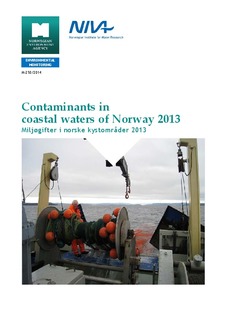Contaminants in coastal waters of Norway 2013
Green, Norman Whitaker; Schøyen, Merete; Øxnevad, Sigurd; Ruus, Anders; Allan, Ian; Hjermann, Dag Øystein; Høgåsen, Tore; Beylich, Bjørnar; Håvardstun, Jarle; Rogne, Åse K Gudmundson; Tveiten, Lise Ann
Research report
Permanent lenke
http://hdl.handle.net/11250/283903Utgivelsesdato
2014Metadata
Vis full innførselSamlinger
- NIVA-rapporter [7006]
- Publikasjoner fra Cristin - NIVA [2160]
Originalversjon
NIVA-rapport. 172 p. Norsk institutt for vannforskning, 2014Sammendrag
This programme examines the levels, trends and effects of contaminants in biota along the coast of Norway. The 2013-investigation included analyses of 120 different contaminants or biological effect parameters in five types of samples (blue mussel, dog whelk, common periwinkle, cod and passive samplers). The contaminants include metals, organochlorines (e.g. PCB, DDT), PAH, polybrominated diphenyl ethers (PBDE), perfluroinated alkylated substances (PFAS) as well as contaminants that have recently received more attention such as hexabromcyclododecane (HBCD), chlorinated paraffins (SCCP, MCCP), phosphorus flame retardants (PFR), bisphenol A (BPA), tetrabrombisphenol A (TBBPA), phthalates and akylphenols. In the report, thirty representative substances or parameters were chosen for analyses of 750 time series (last 10 years). Of these there were statistically significant trends in 90 cases: 66 (9 %) were downwards and 24 (3 %) upwards. The dominance of downward trends indicated that contamination is decreasing for the measured substances. The downwards trends for TBT-concentrations and effect parameter (VDSI) confirmed that the legislation banning the use of TBT has been effective. Of the same 750 cases, 399 could be classified by the environmental classification system used by the Norwegian Environment Agency, 360 (90 %) were classified as insignificantly polluted, 27 (7 %) as moderately polluted, 10 (3 %) as markedly polluted, 1 (<1 %) as severely polluted and 1 (<1 %) as extremely polluted. Some cases warrant special concern, such as upward trend for mercury in cod fillet and high concentrations of several organic pollutants in cod liver from the Inner Oslofjord. Very high concentrations of DDE in mussels from the Sørfjord were related to earlier use of DDT as pesticide in orchards along the fjord.
Beskrivelse
Utgiver
Norsk institutt for vannforskningSerie
NIVA-rapport;6728Miljødirektoratet-rapport;M-250/2014

